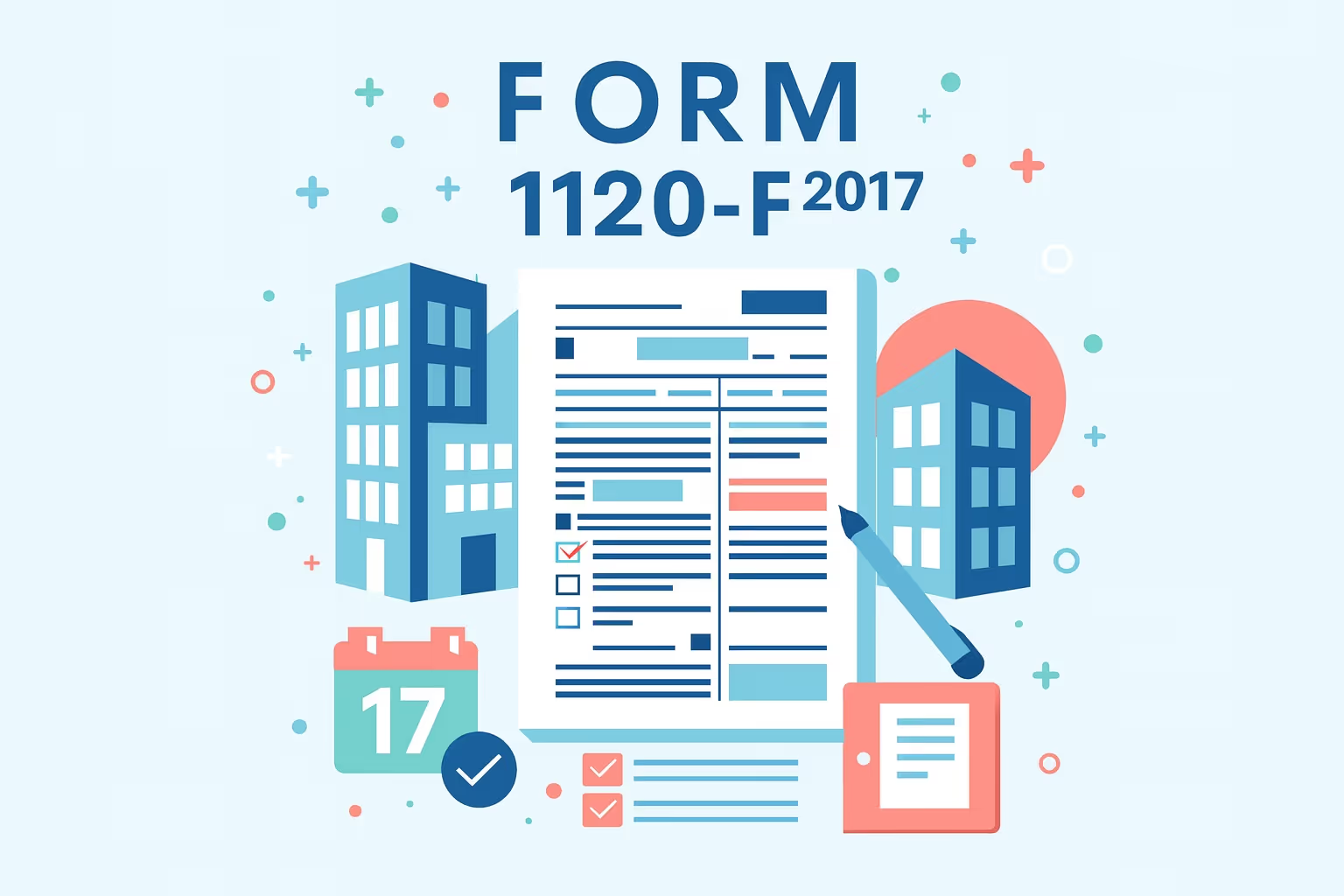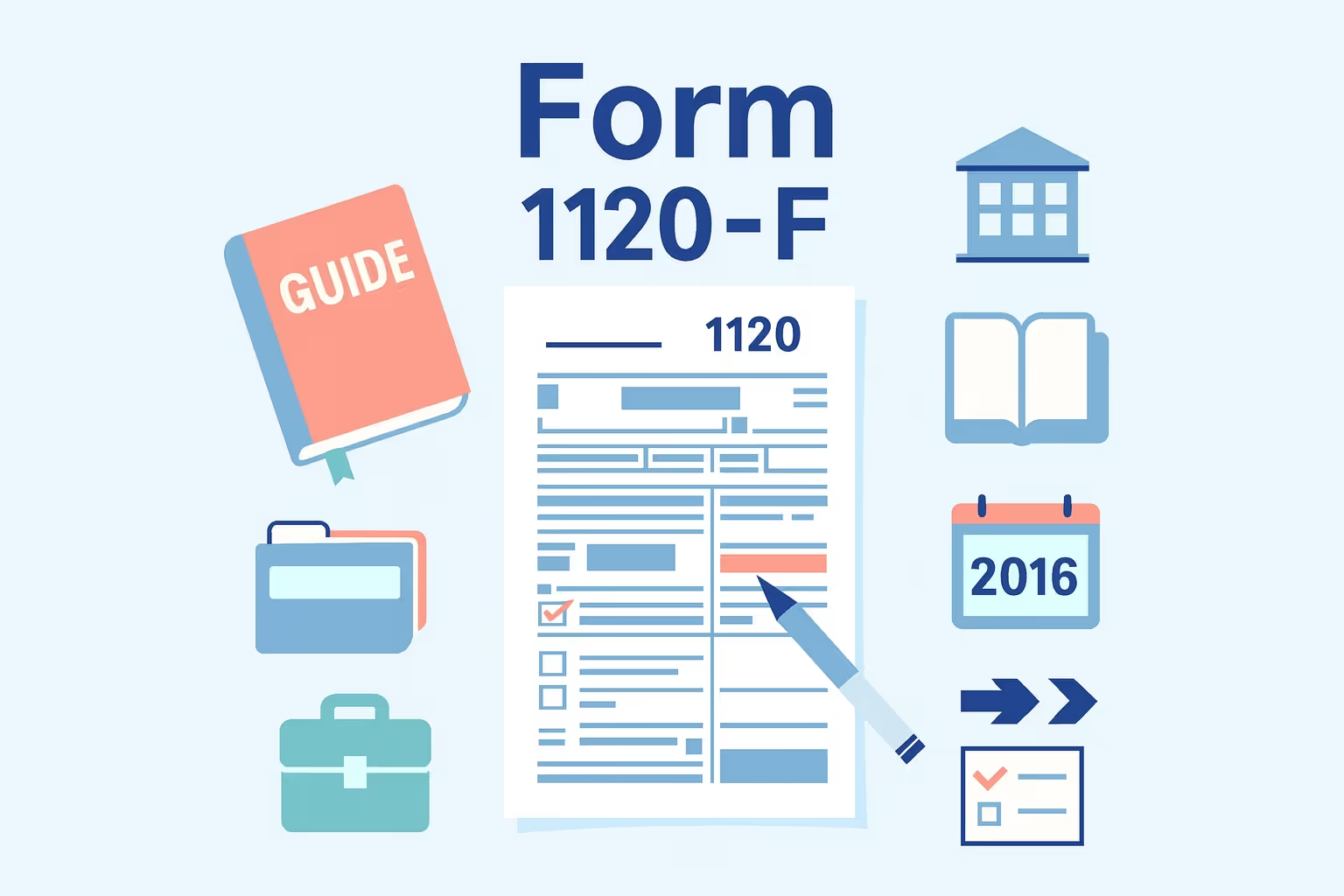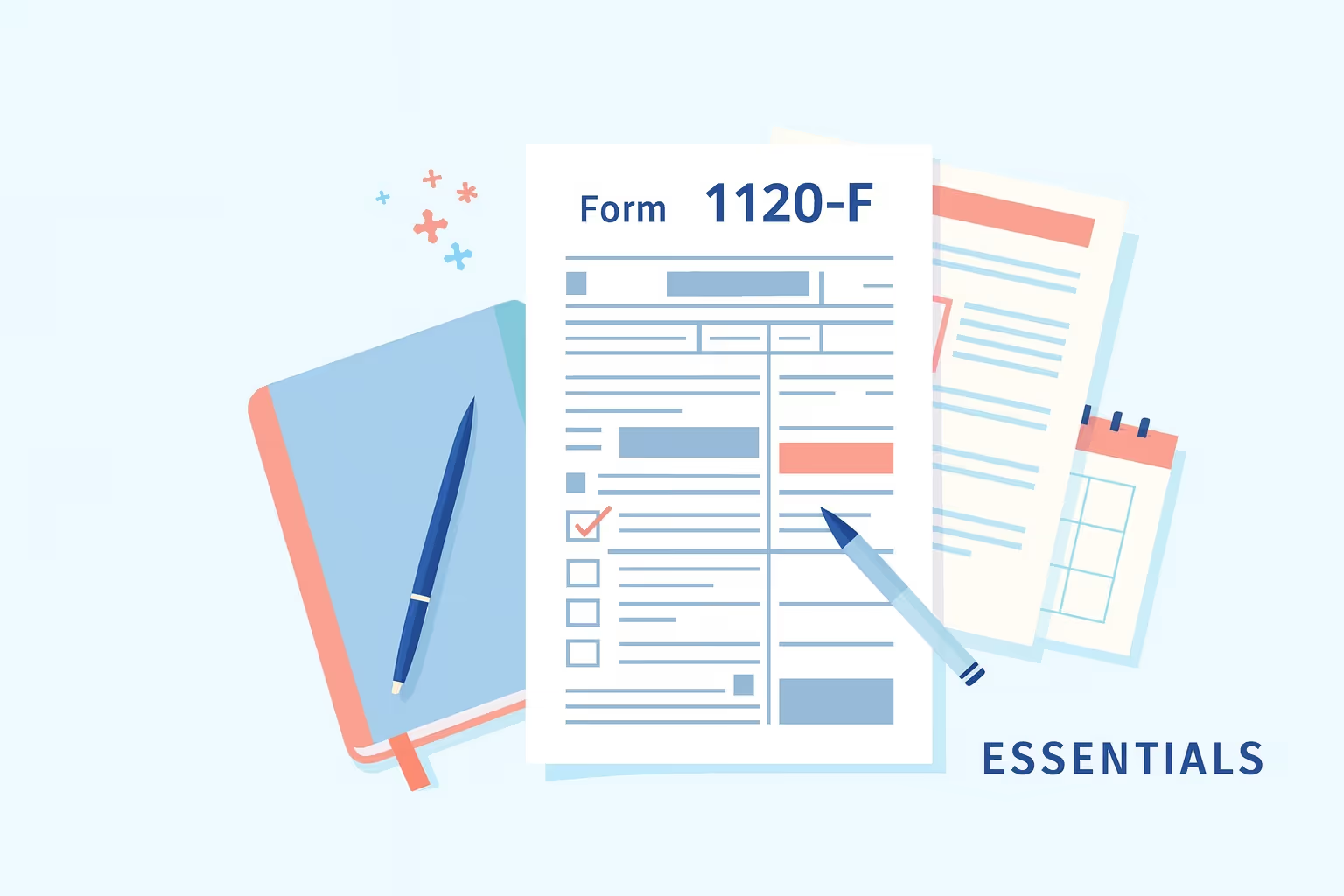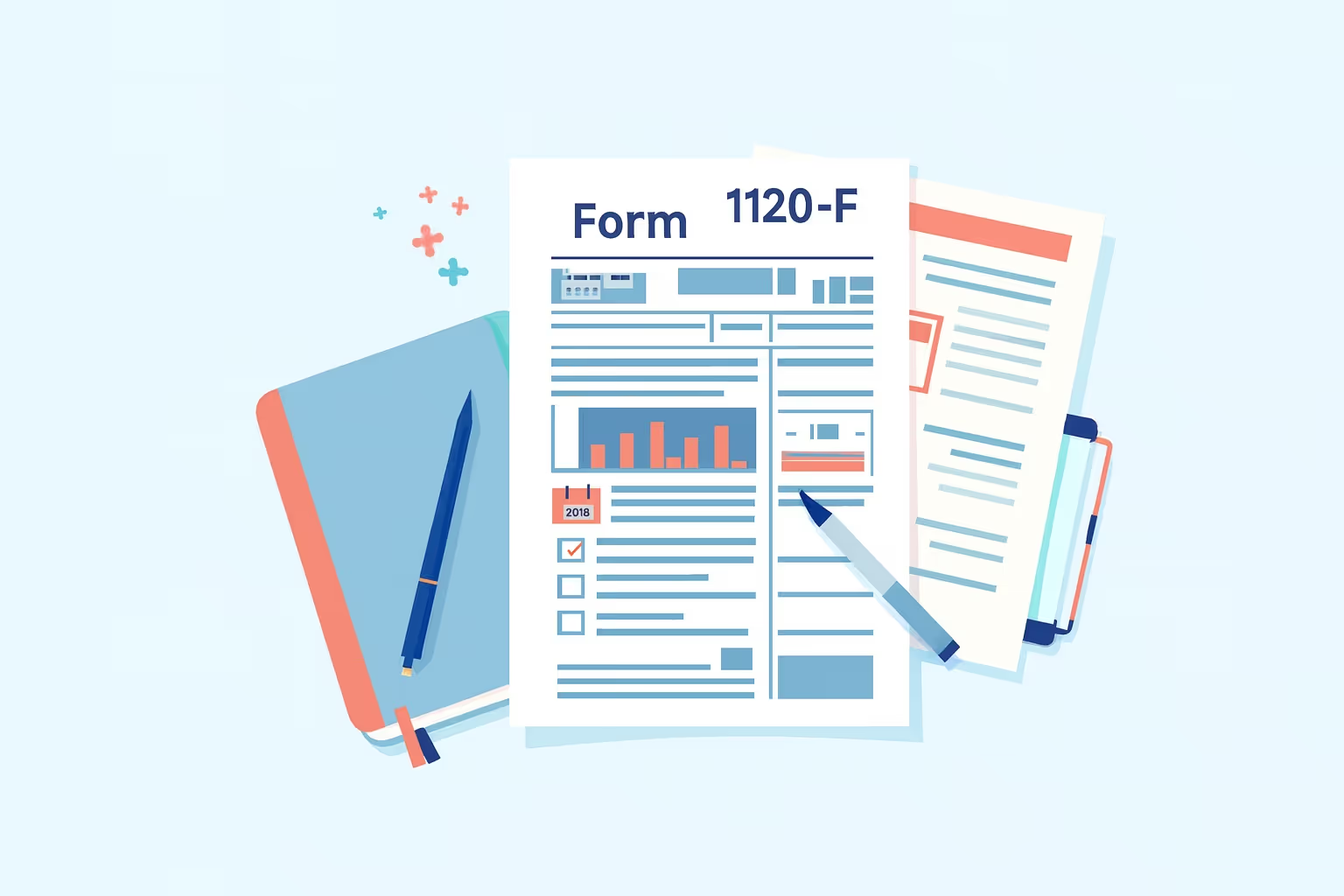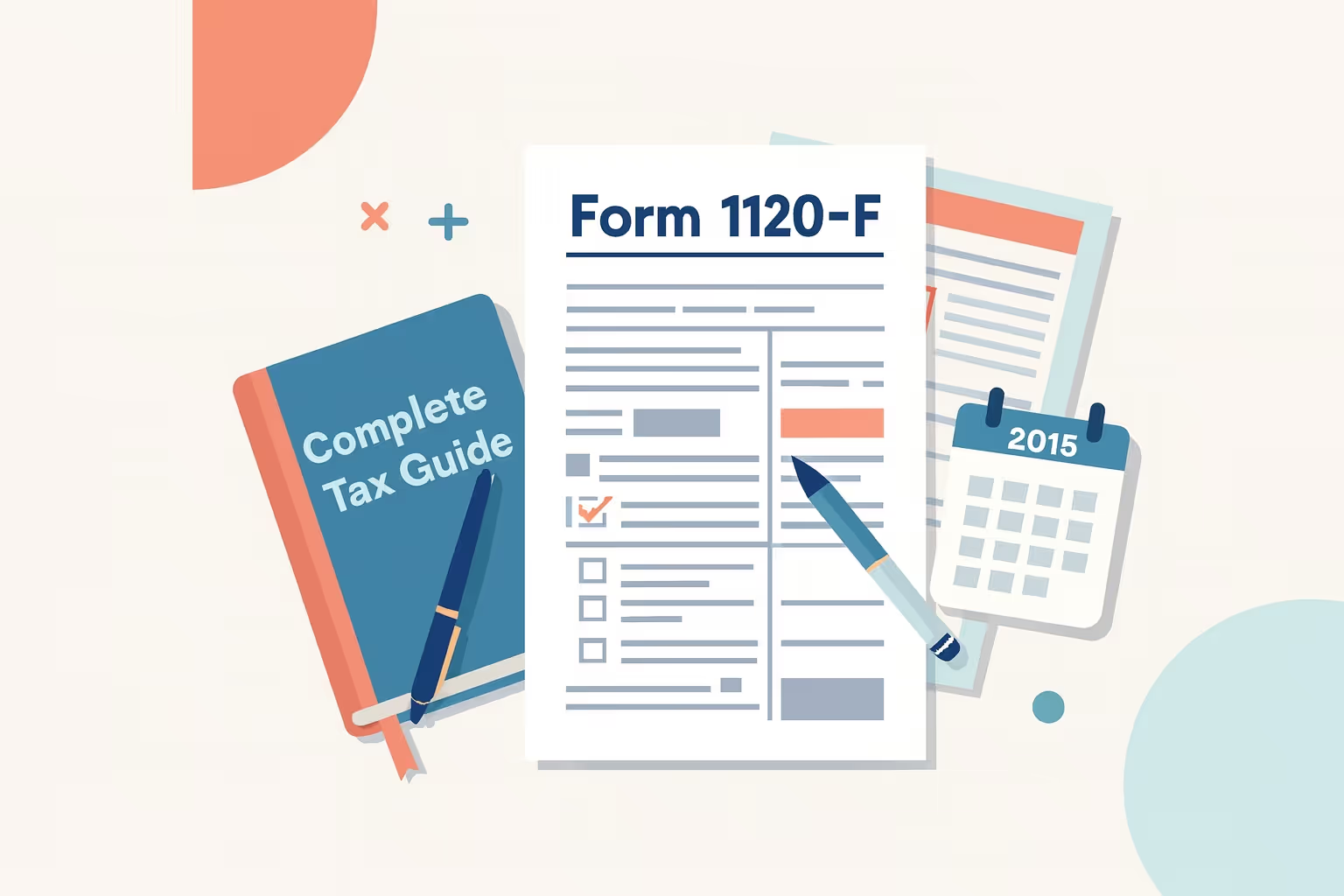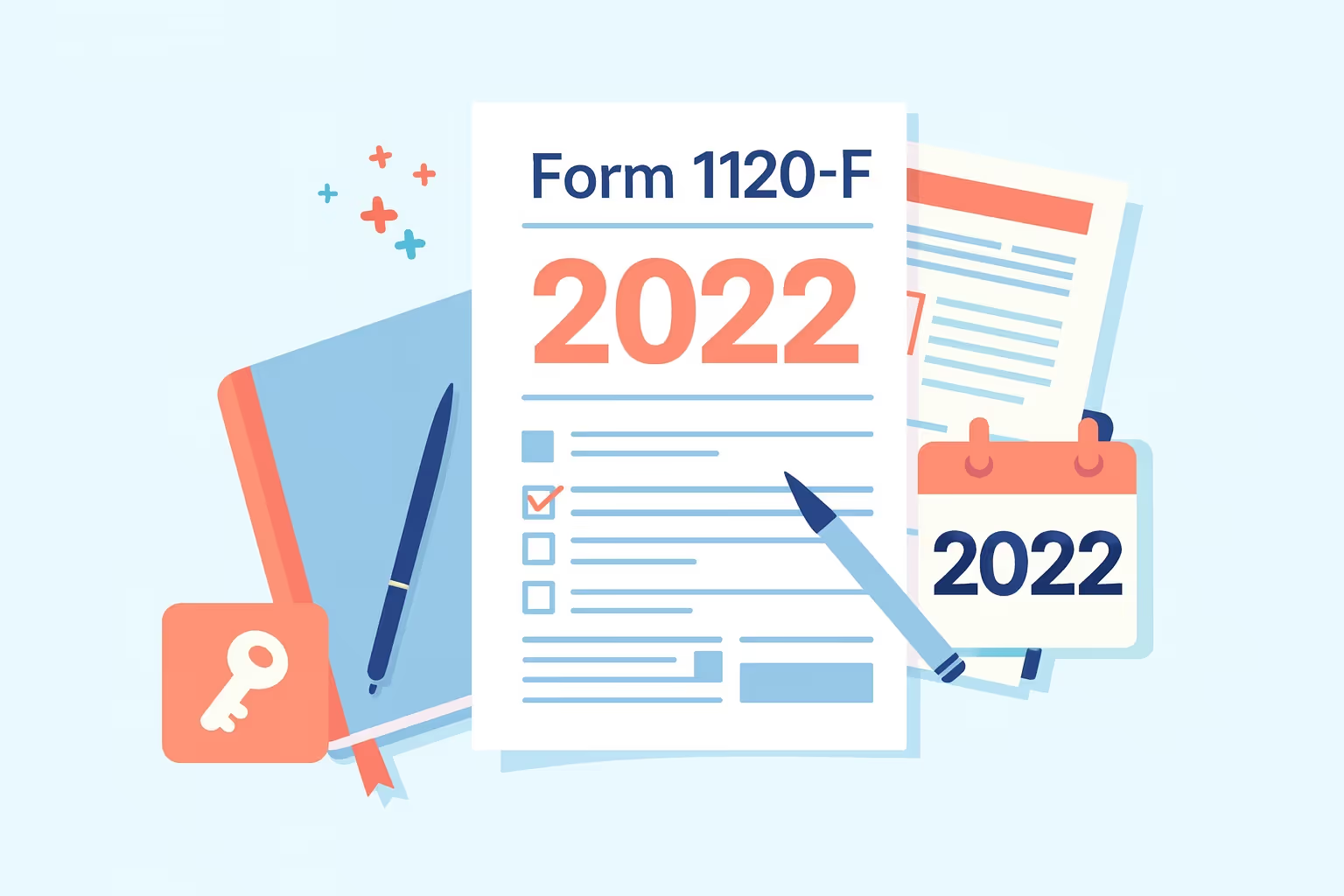Form 1120-F 2023 Instructions for Foreign Tax Compliance
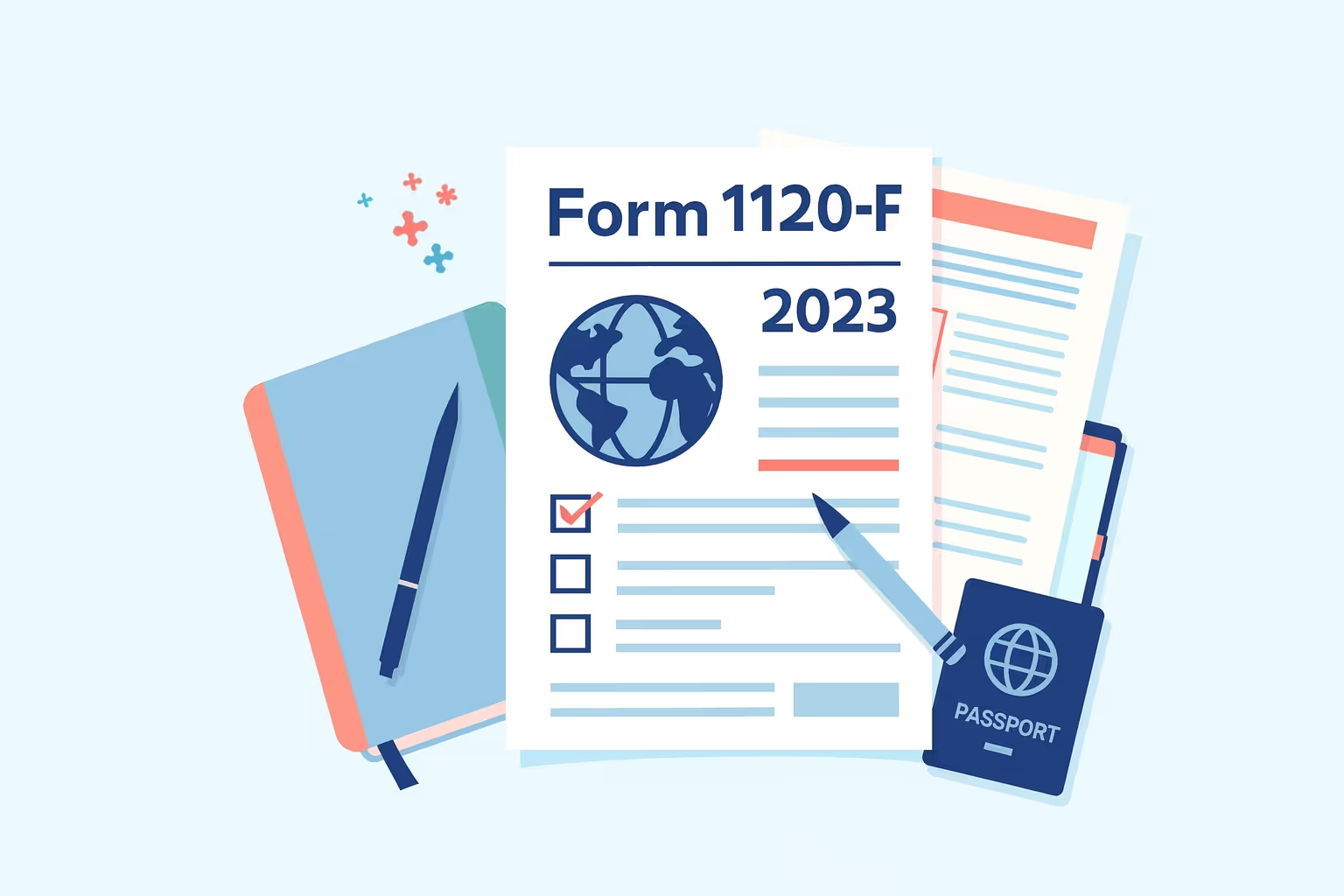
Filing taxes in the United States can be complex for foreign corporations. Form 1120-F—the U.S. Income Tax Return of a Foreign Corporation—is the primary document used to report income, deductions, and credits from activities conducted in the U.S. It determines a company’s income tax liability and ensures compliance with Internal Revenue Service (IRS) regulations. Understanding how and when to file this form is essential for any business with operations or income tied to the United States.
A foreign corporation is any company organized outside the U.S. but engaged in a trade or business within the country. These entities must report Effectively Connected Income (ECI)—income earned through business activities conducted in the U.S.—even if no tax is due. The IRS uses Form 1120-F to assess whether income, gains, and deductions are connected to U.S. operations and to calculate taxes owed. Filing accurately helps corporations avoid penalties, double taxation, or the loss of treaty-based tax benefits.
This guide provides detailed, step-by-step instructions for Form 1120-F 2023 to help foreign corporations confidently meet their U.S. tax obligations. It draws entirely from official IRS publications, ensuring accuracy and compliance. Each section explains the filing process—from identifying who must file to completing required schedules and attachments—so readers can easily navigate the rules, report income correctly, and maintain excellent standing with the IRS.
What is Federal Form 1120-F?
Form 1120-F, officially titled U.S. Income Tax Return of a Foreign Corporation, is used by foreign corporations to report income, gains, losses, deductions, and credits from business conducted within the United States. It helps determine a corporation’s tax liability in the U.S. and ensures that income earned through a U.S. trade or business is taxed appropriately under federal law. You can review the official 2023 version of the form and its instructions directly from the IRS: Form 1120-F 2023 Instructions.
Foreign corporations file this return to disclose two key types of income recognized by the IRS:
- Effectively Connected Income (ECI): Income directly linked to business activities in the United States. ECI is taxed at regular corporate rates, and allowable deductions—such as operating expenses or interest—can be claimed.
- Fixed, Determinable, Annual, or Periodical (FDAP) Income: Income from passive sources such as dividends, rents, royalties, and certain types of interest. FDAP income is generally taxed at a flat 30% rate unless reduced by an applicable tax treaty.
By filing correctly, corporations comply with U.S. tax laws, safeguard eligibility for treaty benefits, and avoid penalties for underreporting income or failing to disclose taxable activities.
Who Must File Form 1120-F
Foreign corporations are required to file Form 1120-F when certain conditions are met. The Internal Revenue Service (IRS) says that a foreign entity needs to file if it was doing business in the United States during the tax year, had income, gains, or losses related to that business, or made U.S. income that wasn't completely taxed at the source. For detailed requirements, visit the official IRS guidance about Form 1120-F.
Key Filing Scenarios
- A foreign corporation that operates a branch, factory, or office in the United States must file Form 1120-F, even if it does not have U.S.-source income.
- A corporation that has had more tax withheld than its actual U.S. income tax liability must file to claim a refund for the overpayment.
- A corporation claiming treaty-based exemptions from U.S. tax must file to disclose its treaty position correctly to the IRS.
- If a corporation is unsure whether it must file, it should submit a protective return to safeguard its right to claim deductions and credits in case the IRS later determines that filing was required.
Situational example:
A foreign corporation maintains a small U.S. distribution office and generates limited sales income from domestic customers. Because its earnings are effectively connected income, it must file Form 1120-F to report its U.S. operations, claim allowable deductions, and ensure compliance with federal tax laws.
What’s New for Tax Year 2023
For tax year 2023, the IRS introduced several updates affecting foreign corporations filing Form 1120-F. These changes align with broader compliance and modernization efforts under federal tax law.
- Lower e-filing threshold: Corporations filing ten or more returns annually must now submit them electronically. This rule expands e-filing to many smaller entities.
- Penalty increase: The minimum penalty for late filing has risen to $485, emphasizing timely submission.
- Corporate Alternative Minimum Tax (CAMT): Certain large corporations are now subject to a 15% minimum tax on adjusted financial statement income.
- Estimated tax relief: The IRS provided temporary penalty relief under Notice 2023-42 for corporations adjusting to CAMT compliance.
- Expired deductions: The 100% deduction for business meals provided by restaurants ended after 2022.
These updates emphasize the importance of staying current with IRS guidance and maintaining accurate foreign tax compliance when filing Form 1120-F 2023.
Step-by-Step Filing Instructions
Filing Form 1120-F requires careful organization and accurate reporting. Each step ensures that foreign persons conducting business in the United States comply with tax purposes and filing requirements under U.S. law.
Step 1 – Gather Required Information
Before starting the form, collect all documents and details needed to complete your return. These include:
- Business identification includes the corporation’s name, country of incorporation, and Employer Identification Number (EIN).
- Financial statements showing gross income, expenses, and credits for the fiscal tax year.
- Supporting documentation for any income earned or deductions claimed.
- Records for transactions between related entities in multiple jurisdictions to clarify how income was earned and allocated for tax purposes.
Having this information organized helps ensure accurate reporting and reduces the risk of penalties or amendments later.
Step 2 – Complete Identifying Information (Items A–G)
Fill out the basic identification section carefully. Include the fiscal tax year ending, total assets, and country of incorporation. If you are uncertain whether you must file, consider submitting a protective form. This filing helps protect your right to claim deductions or credits if the IRS later determines a return was required. The IRS provides specific instructions for reporting both active and passive filings.
Step 3 – Report FDAP Income (Section I)
Foreign corporations must report income not effectively connected with U.S. business activities. This typically includes:
- Dividends, interest, rents, royalties, and gains from securities or other investments.
- Income that may qualify for a lower treaty rate or be exempt under a tax treaty.
Be sure to apply the correct withholding rate and confirm whether any special rules or certain exceptions apply. Each item must be documented with accurate payor and withholding information.
Step 4 – Report Effectively Connected Income (Section II)
Report all income generated from business activities carried out in the United States. Include sales revenue, cost of goods sold, and ordinary business deductions. Foreign corporations are subject to different rules than domestic ones, so refer to the IRS's detailed guidance to ensure that expenses are allocated correctly. Consult a tax professional for complex transactions or adjustments involving foreign individuals when in doubt.
Step 5 – Compute Tax (Schedule J)
Use Schedule J to calculate tax liability. Include regular corporate tax, special rules such as branch profits tax, and applicable credits. Consider how tax implications vary across multiple countries if your company operates in various jurisdictions. Keep calculations consistent with prior filings for the same fiscal tax year.
Step 6 – Review and File the Return
Verify every section for accuracy and confirm that all supporting schedules and attachments are included. Sign and submit the return through e-file or mail according to IRS-specific instructions. Maintain records for future audits and correspondence.
Completing each step helps corporations remain compliant, avoid errors, and confidently file based on accurate information.
How to File Form 1120-F (E-file and Paper)
Foreign corporations have two options for filing Form 1120-F: electronically through the IRS e-file system or mailing a paper return. The correct method depends on filing volume, eligibility, and the corporation’s circumstances during the fiscal tax year.
Electronic Filing (E-file)
The IRS now requires corporations that file ten or more annual returns to submit Form 1120-F electronically. E-filing is strongly encouraged because it provides faster processing, fewer errors, and automatic acknowledgment of receipt.
To file electronically:
- Use IRS-approved tax preparation software compatible with Form 1120-F.
- Enter all necessary information, including identifying details, income figures, and schedules.
- Transmit the return using an authorized e-file provider.
- Keep the confirmation receipt as part of your permanent records.
E-filing helps taxpayers reduce processing delays, ensure accuracy, and receive faster refunds. The IRS also offers specific instructions in its annual filing guidance to help foreign corporations complete the e-file process correctly.
Waivers and Paper Filing
If a corporation cannot e-file due to hardship, technology limitations, or religious objections, it may request a waiver. The request must include an explanation and be submitted to the IRS before filing.
Corporations with an approved waiver can mail a paper return to the appropriate IRS Service Center. Ensure that an authorized officer signs the return and that all attachments are included. The envelope should clearly indicate “Form 1120-F” and the tax year being filed.
Filing Deadlines
Filing deadlines depend on whether the corporation maintains a U.S. office:
- Corporations with a U.S. office: The filing deadline is the 15th day of the fourth month after the end of the tax year.
- Corporations without a U.S. office: The filing deadline is the 15th day of the sixth month after the end of the tax year.
Unlike domestic corporations, foreign entities should allow additional time for international mailing and processing. Filing early helps prevent penalties and ensures full compliance with IRS requirements.
Paying Taxes and Making Estimated Payments
Foreign corporations filing Form 1120-F must pay any U.S. tax owed by the original return due date, even if they obtain a filing extension. Timely payment helps avoid interest and penalties while keeping the business in good standing with the IRS.
Payment Due Dates
Tax payments are generally due by the original filing deadline:
- Corporations with a U.S. office: Payment is due on the 15th day of the fourth month after the close of the tax year.
- Corporations without a U.S. office: Payment is due on the 15th day of the sixth month after the close of the tax year.
These timelines align with IRS requirements for taxpayers engaged in U.S. business activities.
Accepted Payment Methods
Foreign corporations can pay using several options:
- Electronic Federal Tax Payment System (EFTPS): Preferred for corporations with a U.S. bank account.
- Electronic Funds Withdrawal: Payment authorized directly through e-filing software.
- Wire Transfer: Suitable for companies without U.S. banking access.
- Check or Money Order: Payable to “United States Treasury,” including the corporation’s name, EIN, and tax year on the memo line.
Estimated Tax Payments
If a foreign corporation expects to owe $500 or more in tax for the year, it must make quarterly estimated payments. The IRS schedule is as follows:
- 1st Quarter: 15th day of the fourth month of the tax year
- 2nd Quarter: 15th day of the sixth month
- 3rd Quarter: 15th day of the ninth month
- 4th Quarter: 15th day of the twelfth month
Making accurate estimated payments minimizes penalties and supports compliance with U.S. tax law. Consistent recordkeeping ensures that all payments are correctly applied and reflected in future filings.
Required Schedules and Attachments
When completing Form 1120-F, foreign corporations must include all schedules and forms relevant to their operations. These attachments provide the IRS with details about income, deductions, and other financial information necessary to determine the correct income tax liability. Omitting a required schedule can delay processing or trigger penalties, so careful review is essential before submission.
Key Schedules Explained
- Schedule H—Allocation of Deductions to Effectively Connected Income (ECI): Schedule H allocates and apportions deductions between U.S. effectively connected income and non-effectively connected income. Corporations must apply consistent methods to determine which expenses relate directly to U.S. business activities.
- Schedule I – Interest Expense Allocation: This schedule reports how interest expenses are attributed to ECI under Treasury Regulation 1.882-5. Corporations must include supporting calculations and disclose the allocation method selected.
- Schedule P – Partnership Interests: Schedule P is required for corporations with interests in U.S. partnerships. It reports income generated, adjustments to basis, and transfers of partnership interests during the year.
- Schedules M-1 and M-3 – Book-to-Tax Reconciliation: These schedules reconcile differences between financial accounting income and taxable income. Schedule M-1 applies to smaller corporations, while Schedule M-3 is required for entities with total assets of $10 million or more.
- Schedule S or Schedule V – Shipping or Transportation Income: These schedules are used when the corporation claims an exemption under Section 883 or reports income from the operation of ships or aircraft. Accurate reporting ensures eligibility for any applicable tax benefits.
Additional Required Forms
- Form 5472 – Information Return of a 25% Foreign-Owned U.S. Corporation: Required when a foreign entity owns at least 25% of a U.S. corporation or engages in reportable transactions with related parties.
- Form 8833 – Treaty-Based Return Position Disclosure: Must be filed when claiming benefits under a tax treaty that alters U.S. tax obligations. This form helps document treaty positions and avoid penalties for non-disclosure.
- Form 8886 – Reportable Transaction Disclosure Statement: Required for corporations participating in reportable or potentially abusive transactions as defined by the IRS.
- Form 8832 – Entity Classification Election: Used to elect how the foreign entity is treated for federal tax purposes—either as a corporation, partnership, or disregarded entity.
Completing these schedules and attachments properly ensures transparency, supports compliance, and provides the Internal Revenue Service with the detailed information needed to process the income tax return accurately.
Common Mistakes to Avoid
Accuracy is essential when filing Form 1120-F. Even minor errors can cause penalties, delays, or disallowed deductions. The following are some of the most frequent mistakes foreign corporations should avoid:
- Misclassifying ECI and FDAP income: ECI is taxed on a net basis with deductions allowed, while FDAP is taxed on gross income, often at 30% unless reduced by a treaty. Incorrect classification can cause overpayment or underpayment.
- Omitting schedules or attachments: Missing schedules like H, I, or P can result in rejection or processing delays.
- Failing to disclose treaty positions: When claiming treaty benefits, corporations must file Form 8833 to avoid potential penalties of up to $10,000.
- Miscalculating branch profits tax or ECEP: Ensure that asset values and liabilities are updated accurately and all calculations are thoroughly reviewed.
- Poor recordkeeping: Maintain detailed records for at least three years to support filings and treaty claims.
Careful preparation helps ensure compliance and minimizes tax exposure.
Filing for Dormant or Zero-Activity Corporations
Even without income or business activity, some foreign corporations must still file Form 1120-F to maintain compliance and preserve tax benefits. Filing is required if the entity keeps an active EIN, previously engaged in a U.S. trade or business, holds U.S. assets, or wishes to preserve net operating losses for future use.
Corporations with no income, expenses, or deductions may file a simplified return that includes identifying details, confirmation of inactivity, and a signed declaration of accuracy. Entities uncertain about their filing obligation should consider submitting a protective return to safeguard future deductions and credits. If claiming a treaty-based exemption or other exclusion, attach a statement and Form 8833 when applicable. Filing proactively helps maintain good standing and supports future tax positions.
First-Time Filer Guidance
Foreign corporations filing Form 1120-F for the first time should take a few key steps to ensure compliance.
- Obtain an EIN: Apply for an Employer Identification Number (EIN) using Form SS-4 by mail, fax, or phone before filing.
- Choose a Tax Year and Accounting Method: Select a calendar or fiscal tax year and an accounting method—cash or accrual—and use them consistently.
- Maintain Records: Keep detailed records of income, expenses, and U.S. trade or business activities for at least three years.
- Confirm Business Presence: Determine whether operations such as maintaining inventory or employing workers in the U.S. require filing.
- Seek Professional Help: Consult a tax professional for complex filings, treaty claims, or cross-border transactions.
These steps establish compliance and ensure accurate, complete reporting.
Branch Profits Tax Overview
The branch profits tax applies to foreign corporations that conduct business in the United States through a branch instead of a subsidiary. It ensures these entities are taxed similarly to domestic corporations on their distributed profits.
- Purpose: The tax aligns the treatment of foreign branches with domestic corporations that distribute dividends to shareholders.
- Tax Rate: Imposed at a 30% rate on Effectively Connected Earnings and Profits (ECEP) that are not reinvested in U.S. operations or are withdrawn from the country.
- Treaty Reductions: Many tax treaties lower the rate or provide exemptions for qualified corporations.
- Calculation: Determine ECEP, adjust for changes in U.S. net equity, and compute the dividend equivalent amount subject to the branch profits tax.
- Documentation: Maintain detailed records and disclose any treaty-based reductions or exemptions to the IRS as required.
Conclusion
Filing Form 1120-F correctly is essential for complying with U.S. tax law and avoiding costly penalties. Foreign corporations must ensure that all income, deductions, and credits are accurately reported, including those related to effectively connected income and treaty-based positions.
Using the official IRS instructions and publications helps ensure accuracy and consistency across filings. Corporations facing complex issues—such as branch profits tax calculations or multi-jurisdictional income—should seek help from a qualified tax professional.
By keeping thorough records, meeting deadlines, and following all filing requirements, foreign corporations can protect their eligibility for deductions, claim tax benefits properly, and fully comply with IRS rules.
Frequently Asked Questions (FAQs)
Who must file Form 1120-F for foreign corporations?
Foreign corporations that conduct a trade or business within the United States or earn effectively connected income (ECI) must file Form 1120-F. Filing ensures proper income, deductions, and credits reporting while complying with U.S. tax law. Even if no U.S. income exists, filing may still be required to preserve deductions and establish a compliance record with the IRS.
What is reported on an income tax return for foreign corporations?
An income tax return for foreign corporations reports U.S. income, allowable deductions, and credits that reduce income tax liability. It also discloses treaty-based positions and other information the IRS requires. Accurate, complete filing prevents penalties, supports refund claims, and preserves eligibility for tax benefits available under applicable tax treaties and regulations for foreign corporate taxpayers.
What is effectively connected income (ECI)?
Effectively connected income (ECI) is from conducting a U.S. trade or business. It includes sales, services, or activities that generate profits linked to U.S. operations. ECI is taxed on a net basis, meaning corporations can claim deductions related to that income, unlike passive income, which is taxed at a flat rate.
What is a protective form or protective return?
A protective form or return is filed when a corporation is uncertain about its obligation to submit Form 1120-F. Filing it preserves the right to claim deductions, credits, and refunds if the IRS later determines that filing was required. This proactive step safeguards a corporation’s compliance and protects potential tax positions.
How can foreign corporations claim tax benefits under treaties?
Foreign corporations may qualify for reduced income tax rates or exemptions through tax treaties between their home country and the United States. Corporations must disclose treaty positions using Form 8833 when required to claim these tax benefits. Proper documentation ensures that reduced rates or exemptions apply and helps maintain compliance with international tax rules.
















